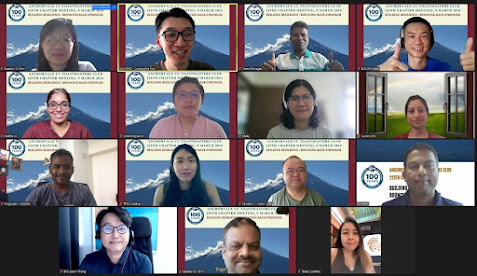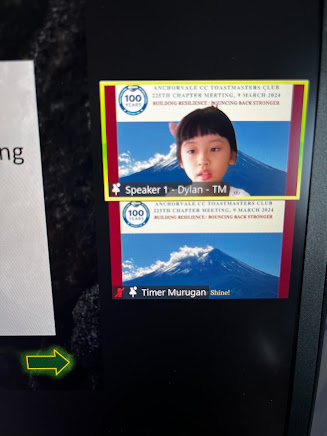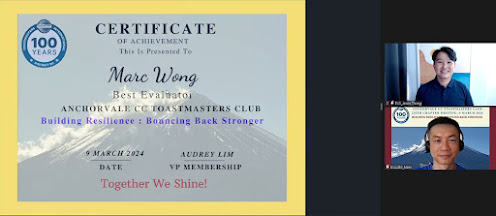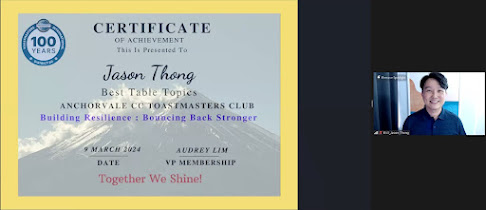The 225th Chapter Meeting commenced with a cheerful note by Sergeant at Arms (SAA), Constantine Koh (SR2) on the theme “Building Resiliency: Bouncing Back Stronger”. He shared that we could cultivate resiliency by stepping out of our comfort zone to attend this afternoon’s Toastmasters session. Constantine doubled up to be the Toastmaster of the Day (TMD). He extended a warm welcome to all toastmasters including the guests and introduced appointment holders who were going to support the chapter meeting.
Audrey Lim (PM3) did the opening address by sharing an analogy of carrot-egg-coffee
bean to illustrate the theme. In the raw form, the carrot is hard, the egg has
a hard shell which could easily crack, and coffee comes in powder form. When
these ingredients are put into the boiling water, the carrot will turn soft,
egg will become hard, and coffee will be dissolved. It very much depends on how
a person perceives and reacts to adversity under immense pressure. She gave the
analogy of the carrot that was soft and weak and could sink into depression
easily and likened the hard-boiled egg to a person whose heart had hardened and
lost trust in people. She encouraged all of us to be like the coffee bean
powder who thrived in adversity and even emitted a fragrant smell. Audrey
emphasized that Adversity Quotient (AQ) was more important than Intelligent
Quotient (IQ) and Emotional Quotient (EQ). Taking ownership and control instead
of wallowing in self-pity was the other key message she tried to send across. Audrey
concluded that Adversity Quotient (AQ) was more important than Intelligent
Quotient (IQ) and Emotional Quotient (EQ).
The 2nd segment of the meeting was the Prepared Speeches Segment delivered by three speakers, Dylan Lam, Srinivasan Kumar and Chong Wee Kim. Dylan’s speech title was “The Art of Communication”. He started off by asking the audience if they had any preferred communication style. He called upon member, Sarah to understand her preferred communication style and she responded that personal feedback should be given in person to be more effective. Marc was next called upon and his preferred communication style was one that is more open and direct. Dylan himself preferred assertive communication style. He re-enacted the scene whereby he used assertive communication to work with 2 project team members, Jason and Mary. Their team would need to complete a project within 2 days for a customer. Jason was skeptical if it could be achieved and suggested past project where a backup Plan B was activated. Dylan then turned to Mary to ask for her opinion. Mary did not think Jason’s plan would work and suggested making refinements to the plan. After the illustration, Dylan emphasized assertive communication should be 2-way to allow all parties to exchange their ideas. The more the team members shared their ideas, the more positive results the team would get which could lead to a highly effective team. Dylan’s concluded that in order for assertive communication to work, team members must be willing to share and be respectful towards one another.
In Srinivasan’s speech
titled “Understanding Your Leadership Style”, he started off by informing the
audience to close their eyes for 10 seconds and asked three questions – 1. Were
we a leader?; 2. How to be a better leader?; 3. Did we agree to be a better
leader and would act on it? Srinivasan shared that he had spent 14 hours
researching leadership styles. He explained everyone has skills, knowledge and
behaviors but an effective leader would need to possess these five
characteristics, i.e.(i) effective communicator, (ii) optimistic, (iii)
open-minded, (iv) live by example and (v) demonstrate integrity.
Srinivasan displayed a colorful wallpaper in Zoom that showed the different styles of leadership. He narrated for autocratic leadership; the leader made decision without requiring input from team members. He illustrated people-oriented leadership would take place in Sales Teams where the Sales Director would seek input all the Sales Teams. Tapping on his personal experience, Srinivasan cited his involvement in launching a Campaign that involved collaboration with teams from multiple countries. The duration of the Campaign was successfully reduced from 9 weeks to 4 weeks using effective communication techniques. He further explained that leadership could also be applied to our day-to-day activities, not just for work. For example, parents could use autocratic leadership style to get the kids to complete their homework. If a group of friends planned on a vacation, then collaborative leadership would be needed. He concluded by reminding the audience to connect the dots between leadership and communication to become an effective leader.
In Kim’s speech titled
“Secrets behind Successful Products”, she started off asking the audience to
ponder why some products failed and why some products survived and thrived. She
shared her insights gained from reading products’ case studies and interactions
with some product managers from Women in Tech event that happened the day
before. The first secret sauce would be products that focused on Customer
Centricity. She quoted Jeff Bezos’s
belief “We see our customers as invited guests to a party, and we are the
hosts. It's our job everyday to make every important aspect of the customer
experience a little bit better”. Kim also shared that Tan Hooi Ling, Grab CEO was
fearful of her safety in taking taxi in Malaysia especially at night years ago,
just like any of the Malaysians. Once she boarded the taxi, she had to message her
parents the taxi’s car plate number. This was a very serious pain point that
pierced through the hearts of the Malaysians. Another example was the legal and
privacy issues that surrounded the music industry back then when a lot of
consumers downloaded music playlist into CD or MP3 player. Spotify was born and
started off offering small streaming library to allow people to listen to music
on the go.
She highlighted that
the key to getting started on a product was to find the pain point that
consumers could resonate with.
The second secret sauce was to start small and experiment following Amazon’s motto “Fail fast, fail often and fail forward”. She shared that Tan Hooi Ling rolled out GrabHitch which was not successful but that did not make her give up her dream. She continued to experiment and in Vietnam, she studied the market localization and introduced the first GrabBike service as a trial service which proved to be popular with the locals. During the experimentation phase, it was important for the product team to monitor Key Performance Indicators (KPIs), duration and when is the point to issue surrender flag.
The third secret sauce depended on the product’s flexible pricing model. Kim opined that people in general liked free things. Her daughter was a classic example as she listened to Spotify on freemium plan. Kim did not allow her daughter to subscribe to a premium service for now as she is still a student. Kim shared that from her interaction with Spotify’s Product Manager on how Spotify premium model worked. Spotify had introduced Artificial Intelligence-powered Disc Jockey (AI-powered DJ) premium service that leveraged on OpenAI. OpenAI is a research organisation with a mission to create safe and beneficial artificial general intelligence (AGI). For premium customers, they could select this DJ service and then invite freemium customers to join. Spotify took into consideration the whole ecosystem to grow premium consumers as well as to convert freemium into premium consumers. In conclusion, she reiterated these three key ingredients, i.e. customer centricity, small experimentation of new ideas and flexible pricing model were secrets behind successful digital products.
Table topic segment
was presented by Audrey Lim and the table topics questions were related to the
meeting theme on building resiliency and bouncing back strong. Some of the
participants gave insights through their memorable life stories of how they had
overcome obstacles. Adopting a positive mindset and learning from failures
really stroke a common chord among us! Even our young guest, Raelyn Lam has bravely attempted the table
topic.
In the evaluation segment, Iman Hossain (PM2), Marc Wong (DL5, PM1) and Jason Thong (PM5) presented constructive feedback and recommendations to the Project Speakers.
The awards were
presented to the following top winners.
Best Speaker: Chong Wee Kim, TM
Best Project Evaluator: Jason Thong, PM5
Best Table Topics: Jason Thong (PM5) and Marc Wong (DL5 PM1)
We sincerely appreciated all appointment holders for preparing and making this Chapter meeting a success and were grateful to all guests and members who took time to attend this online Zoom meeting.
Do stay tune for our next chapter meeting and we welcome you to join us as guest.
Together We Shine!
Anchorvale CC Toastmasters Club
Written by Chong Wee Kim, TM








No comments:
Post a Comment